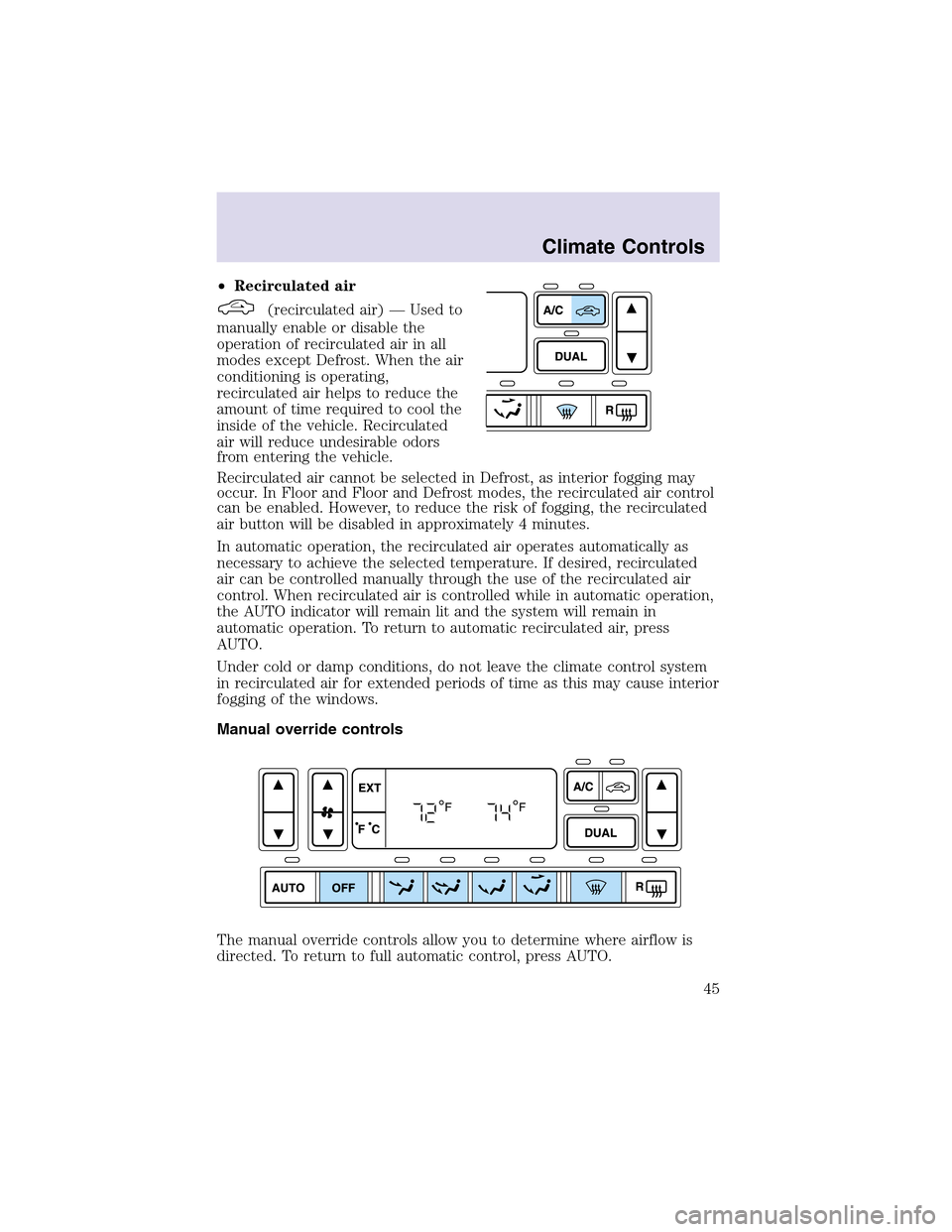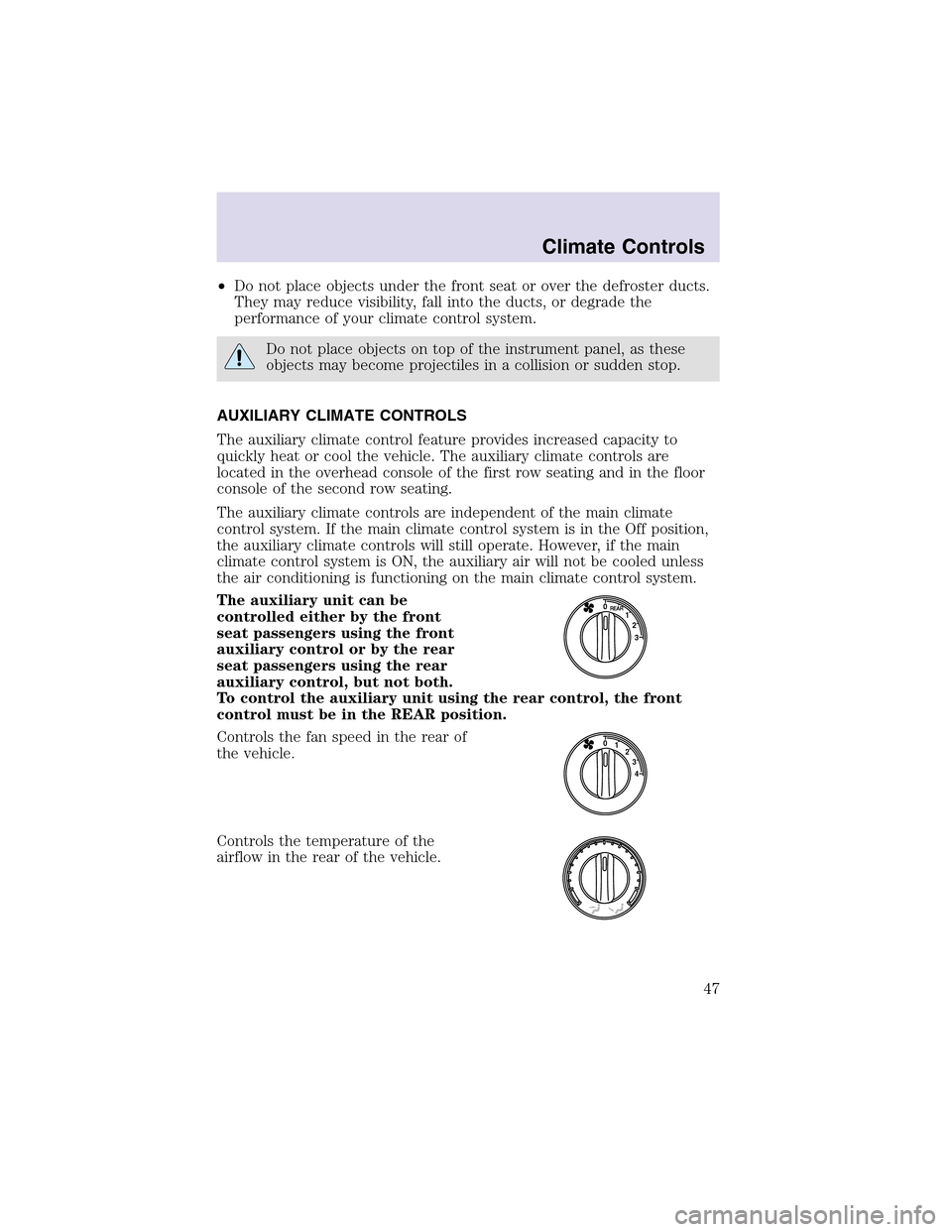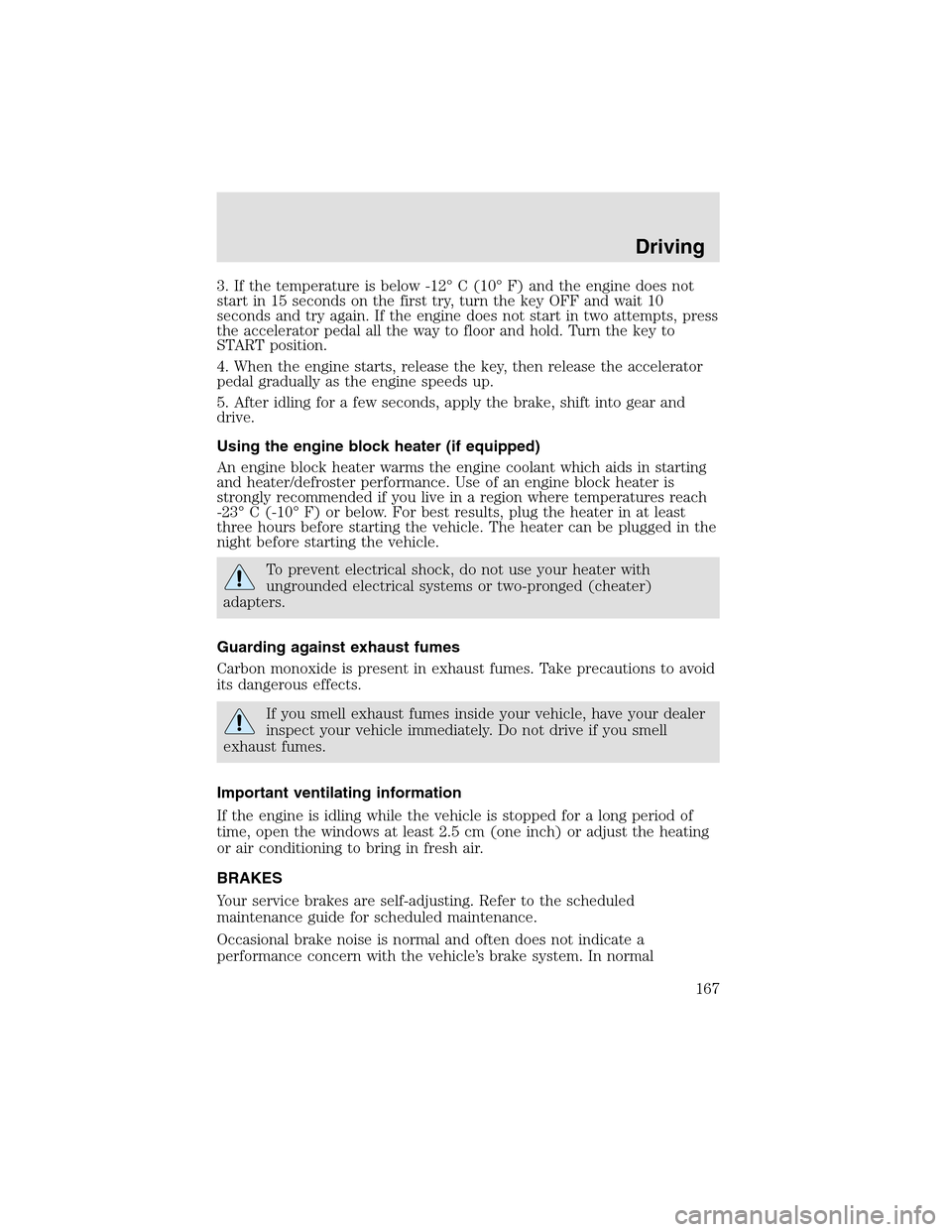2003 LINCOLN AVIATOR air conditioning
[x] Cancel search: air conditioningPage 44 of 288

Fan speed ()
When in automatic operation, fan
speed operates as necessary to
achieve the selected temperature. If
desired, the fan speed can be
adjusted manually through the use
of the fan speed control.
•A/C control
A/C(air conditioning) — Used to
manually enable or disable air
conditioning in all modes except
Defrost. The A/C will only function
if the outside temperature is above
approximately 2°C (35°F). In
Defrost, the A/C will operate
automatically if the outside
temperature is above approximately
2°C (35°F). However, the A/C indicator will not be lit in Defrost mode.
In automatic operation, the air conditioning operates as necessary to
achieve the selected temperature and the A/C indicator will be lit if the
outside temperature is above approximately 2°C (35°F). You may
override the automatic A/C operation at any time. To manually control
the A/C operation and cancel automatic A/C operation, press the A/C
control. When the air conditioning is manually controlled in automatic
operation, the AUTO indicator will remain lit. To return to automatic air
conditioning operation, press AUTO.
Since the air conditioner removes moisture from the air, it is considered
normal operation if clear water drips on the ground under the air
conditioner drain.
Climate Controls
44
Page 45 of 288

•Recirculated air
(recirculated air) — Used to
manually enable or disable the
operation of recirculated air in all
modes except Defrost. When the air
conditioning is operating,
recirculated air helps to reduce the
amount of time required to cool the
inside of the vehicle. Recirculated
air will reduce undesirable odors
from entering the vehicle.
Recirculated air cannot be selected in Defrost, as interior fogging may
occur. In Floor and Floor and Defrost modes, the recirculated air control
can be enabled. However, to reduce the risk of fogging, the recirculated
air button will be disabled in approximately 4 minutes.
In automatic operation, the recirculated air operates automatically as
necessary to achieve the selected temperature. If desired, recirculated
air can be controlled manually through the use of the recirculated air
control. When recirculated air is controlled while in automatic operation,
the AUTO indicator will remain lit and the system will remain in
automatic operation. To return to automatic recirculated air, press
AUTO.
Under cold or dampconditions, do not leave the climate control system
in recirculated air for extended periods of time as this may cause interior
fogging of the windows.
Manual override controls
The manual override controls allow you to determine where airflow is
directed. To return to full automatic control, press AUTO.
Climate Controls
45
Page 47 of 288

•Do not place objects under the front seat or over the defroster ducts.
They may reduce visibility, fall into the ducts, or degrade the
performance of your climate control system.
Do not place objects on top of the instrument panel, as these
objects may become projectiles in a collision or sudden stop.
AUXILIARY CLIMATE CONTROLS
The auxiliary climate control feature provides increased capacity to
quickly heat or cool the vehicle. The auxiliary climate controls are
located in the overhead console of the first row seating and in the floor
console of the second row seating.
The auxiliary climate controls are independent of the main climate
control system. If the main climate control system is in the Off position,
the auxiliary climate controls will still operate. However, if the main
climate control system is ON, the auxiliary air will not be cooled unless
the air conditioning is functioning on the main climate control system.
The auxiliary unit can be
controlled either by the front
seat passengers using the front
auxiliary control or by the rear
seat passengers using the rear
auxiliary control, but not both.
To control the auxiliary unit using the rear control, the front
control must be in the REAR position.
Controls the fan speed in the rear of
the vehicle.
Controls the temperature of the
airflow in the rear of the vehicle.
3 2 1 0
REAR
4 3 2 0
1
Climate Controls
47
Page 87 of 288

conditions. If the compass still appears to be inaccurate, a manual
calibration may be necessary. Refer toCompass zone/calibration
adjustment.
Most geographic areas (zones) have a magnetic north compass point that
varies slightly from the northerly direction on maps. This variation is four
degrees between adjacent zones and will become noticeable as the
vehicle crosses multiple zones. A correct zone setting will eliminate this
error. Refer toCompass zone/calibration adjustment.
Compass zone/calibration adjustment
Perform this adjustment in an open area free from steel structures and
high voltage lines.
For optimum calibration, turn off all electrical accessories (heater/air
conditioning, wipers, etc.) and make sure all vehicle doors are shut.
1. Turn ignition to the ON position.
2. Start the engine.
3. Determine your magnetic zone by
referring to the zone map.
4. From Info menu, select the
Compass/Odometer function. (Do
not select Trip, DTE, or AFE. The
topof the message center must be
blank).
5. Press and hold the RESET and
SETUP control until the message
center display changes to show the
current zone setting.
6. Release the RESET AND SETUP
control, then slowly press RESET
down again.
7. Press the SETUP control
repeatedly until the correct zone
setting for your geographic location is displayed on the message center.
To exit the zone setting mode press and release the RESET control.
1
4
5
6 7 8 9 101112 13 15
Driver Controls
87
Page 167 of 288

3. If the temperature is below -12° C (10° F) and the engine does not
start in 15 seconds on the first try, turn the key OFF and wait 10
seconds and try again. If the engine does not start in two attempts, press
the accelerator pedal all the way to floor and hold. Turn the key to
START position.
4. When the engine starts, release the key, then release the accelerator
pedal gradually as the engine speeds up.
5. After idling for a few seconds, apply the brake, shift into gear and
drive.
Using the engine block heater (if equipped)
An engine block heater warms the engine coolant which aids in starting
and heater/defroster performance. Use of an engine block heater is
strongly recommended if you live in a region where temperatures reach
-23° C (-10° F) or below. For best results, plug the heater in at least
three hours before starting the vehicle. The heater can be plugged in the
night before starting the vehicle.
To prevent electrical shock, do not use your heater with
ungrounded electrical systems or two-pronged (cheater)
adapters.
Guarding against exhaust fumes
Carbon monoxide is present in exhaust fumes. Take precautions to avoid
its dangerous effects.
If you smell exhaust fumes inside your vehicle, have your dealer
inspect your vehicle immediately. Do not drive if you smell
exhaust fumes.
Important ventilating information
If the engine is idling while the vehicle is stopped for a long period of
time, open the windows at least 2.5 cm (one inch) or adjust the heating
or air conditioning to bring in fresh air.
BRAKES
Your service brakes are self-adjusting. Refer to the scheduled
maintenance guide for scheduled maintenance.
Occasional brake noise is normal and often does not indicate a
performance concern with the vehicle’s brake system. In normal
Driving
167
Page 254 of 288

•Extreme cold:increase the coolant concentration above 50%.
NEVER increase the coolant concentration above 60%.
•Extreme hot:it is acceptable to decrease the coolant concentration
below 50%.NEVER decrease the coolant concentration below
40%.
The coolant concentration in severe climates must always be
between 40% and 60%.Coolant concentrations not within the
40%-60% range may cause engine damage.
Refer to the chart on the coolant container to ensure the coolant
concentration in your vehicle will provide adequate protection at the
temperatures in which you drive.
What you should know about fail-safe cooling
If the engine coolant supply is depleted, this feature allows the vehicle to
be driven temporarily before incremental component damage is incurred.
The “fail-safe” distance depends on ambient temperatures, vehicle load
and terrain.
How fail-safe cooling works
If the engine begins to overheat:
•The engine coolant temperature
gauge will move to the red (hot)
area.
•The
and thesymbol
will illuminate.
•The “Service Engine Soon”
indicator light will illuminate.
If the engine reaches a preset over-temperature condition, the engine
will automatically switch to alternating cylinder operation. Each disabled
cylinder acts as an air pump and cools the engine.
When this occurs the vehicle will still operate. However:
•The engine power will be limited.
•The air conditioning system will be disabled.
Continued operation will increase the engine temperature:
•The engine will completely shut down.
•Steering and braking effort will increase.
Once the engine temperature cools, the engine can be re-started. Take
your vehicle to a service facility as soon as possible to minimize engine
damage.
Maintenance and Specifications
254
Page 281 of 288

A
ABS (see Brakes) .....................168
Accessory delay ..........................73
Air bag supplemental
restraint system ........143–144, 147
and child safety seats ............145
description ......................144, 147
disposal ....................................151
driver air bag ..................146, 148
indicator light ...................12, 150
operation .........................146, 148
passenger air bag ...........146, 148
side air bag ..............................147
Air cleaner filter .......................270
Air conditioning ..........................41
auxiliary heater and air
conditioner ................................47
All Wheel Drive (AWD),
driving off road .........................181
Ambulance packages ....................7
Antifreeze
(see Engine coolant) ................251
Anti-lock brake system
(see Brakes) ......................168–169
Anti-theft system ......................117
arming the system ..................117
disarming a triggered
system .....................................118
Audio system (see Radio) ...18, 27
Automatic transmission
driving an automatic
overdrive .................................176
fluid, adding ............................265
fluid, checking ........................265
fluid, refill capacities ..............270
fluid, specification ..................275
Auxiliary power point .................69Axle
lubricant
specifications ..................273, 275
refill capacities ........................270
B
Battery .......................................249
acid, treating emergencies .....249
charging system warning
light ............................................12
jumping a disabled battery ....219
maintenance-free ....................249
replacement, specifications ...270
servicing ..................................249
BeltMinder .................................139
Brakes ........................................167
anti-lock ...........................168–169
anti-lock brake system
(ABS) warning light .........12, 169
brake warning light ..................11
fluid, checking and adding ....265
fluid, refill capacities ..............270
fluid, specifications .........273, 275
lubricant
specifications ..................273, 275
parking ....................................169
shift interlock ..........................174
Bulbs ............................................56
C
Calculating load ........................193
Capacities for refilling fluids ....270
Cargo cover ...............................102
CD-single premium .....................18
Cell phone use ............................98
Certification Label ....................276
Changing a tire .........................211
Index
281
Page 284 of 288

H
Hazard flashers .........................201
Head restraints .........................121
Headlamps ...................................50
aiming ........................................53
autolampsystem .......................50
bulb specifications ....................56
daytime running lights .............52
high beam ...........................14, 52
replacing bulbs .........................58
turning on and off ....................50
warning chime ..........................14
Heating
heating and air conditioning
system .......................................41
HomeLink universal
transceiver (see Garage door
opener) ............................82, 84–85
I
Ignition ...............................164, 275
Infant seats
(see Safety seats) .....................154
Inspection/maintenance (I/M)
testing ........................................264
Instrument panel
cleaning ...................................239
cluster ........................................10
lighting uppanel and interior .53
J
Jack ....................................211, 213
positioning .......................211, 215
storage .............................211, 213
Jump-starting your vehicle ......219K
Keyless entry system
locking and unlocking doors ..113
programming entry code .......111
Keys ...................................114–116
key in ignition chime ...............14
positions of the ignition .........164
L
Lamps
autolampsystem .......................50
bulb replacement
specifications chart ..................56
cargo lamps ...............................53
daytime running light ...............52
fog lamps ...................................50
headlamps .................................50
instrument panel, dimming .....53
interior lamps .....................55, 57
replacing bulbs .......56, 58, 60–63
Lane change indicator
(see Turn signal) ........................55
Liftgate ..............................100, 105
Lights, warning and indicator ....10
AdvanceTrac .............................13
air bag ........................................12
anti-lock brakes (ABS) ....12, 169
brake ..........................................11
charging system ........................12
cruise indicator .........................13
high beam .................................14
low coolant ................................13
oil pressure ...............................13
overdrive off ..............................14
safety belt .................................12
service engine soon ..................10
speed control ............................80
turn signal indicator .................13
Load limits .................................191
Index
284